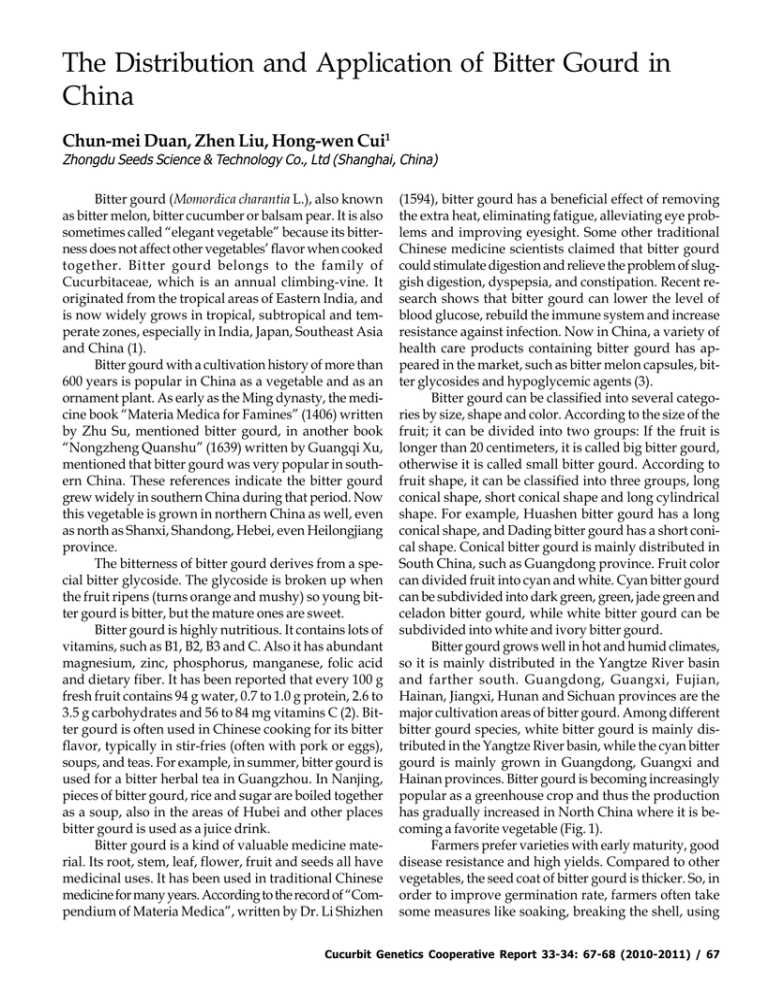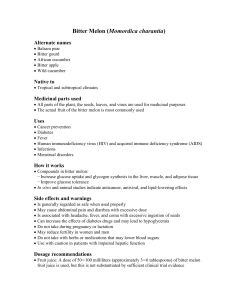The Distribution and Application of Bitter Gourd in China
advertisement

The Distribution and Application of Bitter Gourd in China Chun-mei Duan, Zhen Liu, Hong-wen Cui1 Zhongdu Seeds Science & Technology Co., Ltd (Shanghai, China) Bitter gourd (Momordica charantia L.), also known as bitter melon, bitter cucumber or balsam pear. It is also sometimes called “elegant vegetable” because its bitterness does not affect other vegetables’ flavor when cooked together. Bitter gourd belongs to the family of Cucurbitaceae, which is an annual climbing-vine. It originated from the tropical areas of Eastern India, and is now widely grows in tropical, subtropical and temperate zones, especially in India, Japan, Southeast Asia and China (1). Bitter gourd with a cultivation history of more than 600 years is popular in China as a vegetable and as an ornament plant. As early as the Ming dynasty, the medicine book “Materia Medica for Famines” (1406) written by Zhu Su, mentioned bitter gourd, in another book “Nongzheng Quanshu” (1639) written by Guangqi Xu, mentioned that bitter gourd was very popular in southern China. These references indicate the bitter gourd grew widely in southern China during that period. Now this vegetable is grown in northern China as well, even as north as Shanxi, Shandong, Hebei, even Heilongjiang province. The bitterness of bitter gourd derives from a special bitter glycoside. The glycoside is broken up when the fruit ripens (turns orange and mushy) so young bitter gourd is bitter, but the mature ones are sweet. Bitter gourd is highly nutritious. It contains lots of vitamins, such as B1, B2, B3 and C. Also it has abundant magnesium, zinc, phosphorus, manganese, folic acid and dietary fiber. It has been reported that every 100 g fresh fruit contains 94 g water, 0.7 to 1.0 g protein, 2.6 to 3.5 g carbohydrates and 56 to 84 mg vitamins C (2). Bitter gourd is often used in Chinese cooking for its bitter flavor, typically in stir-fries (often with pork or eggs), soups, and teas. For example, in summer, bitter gourd is used for a bitter herbal tea in Guangzhou. In Nanjing, pieces of bitter gourd, rice and sugar are boiled together as a soup, also in the areas of Hubei and other places bitter gourd is used as a juice drink. Bitter gourd is a kind of valuable medicine material. Its root, stem, leaf, flower, fruit and seeds all have medicinal uses. It has been used in traditional Chinese medicine for many years. According to the record of “Compendium of Materia Medica”, written by Dr. Li Shizhen (1594), bitter gourd has a beneficial effect of removing the extra heat, eliminating fatigue, alleviating eye problems and improving eyesight. Some other traditional Chinese medicine scientists claimed that bitter gourd could stimulate digestion and relieve the problem of sluggish digestion, dyspepsia, and constipation. Recent research shows that bitter gourd can lower the level of blood glucose, rebuild the immune system and increase resistance against infection. Now in China, a variety of health care products containing bitter gourd has appeared in the market, such as bitter melon capsules, bitter glycosides and hypoglycemic agents (3). Bitter gourd can be classified into several categories by size, shape and color. According to the size of the fruit; it can be divided into two groups: If the fruit is longer than 20 centimeters, it is called big bitter gourd, otherwise it is called small bitter gourd. According to fruit shape, it can be classified into three groups, long conical shape, short conical shape and long cylindrical shape. For example, Huashen bitter gourd has a long conical shape, and Dading bitter gourd has a short conical shape. Conical bitter gourd is mainly distributed in South China, such as Guangdong province. Fruit color can divided fruit into cyan and white. Cyan bitter gourd can be subdivided into dark green, green, jade green and celadon bitter gourd, while white bitter gourd can be subdivided into white and ivory bitter gourd. Bitter gourd grows well in hot and humid climates, so it is mainly distributed in the Yangtze River basin and farther south. Guangdong, Guangxi, Fujian, Hainan, Jiangxi, Hunan and Sichuan provinces are the major cultivation areas of bitter gourd. Among different bitter gourd species, white bitter gourd is mainly distributed in the Yangtze River basin, while the cyan bitter gourd is mainly grown in Guangdong, Guangxi and Hainan provinces. Bitter gourd is becoming increasingly popular as a greenhouse crop and thus the production has gradually increased in North China where it is becoming a favorite vegetable (Fig. 1). Farmers prefer varieties with early maturity, good disease resistance and high yields. Compared to other vegetables, the seed coat of bitter gourd is thicker. So, in order to improve germination rate, farmers often take some measures like soaking, breaking the shell, using Cucurbit Genetics Cooperative Report 33-34: 67-68 (2010-2011) / 67 chemicals, and so on. In the preliminary growth state, it is necessary to prune the extra branches and leave a main stem. However, above 1.5 meters, strong lateral branches can be left on the plant. Under normal circumstances, bitter gourd begins to flower at 40-45 days after sowing, and continue throughout a season of usually six months. Bitter gourd can be pollinated by insect like bees, or if grown in the greenhouse sometimes it needs hand pollination. After 15-20 days pollination, the fruit can be harvested. Picking too early or late will reduce the quality and yield of this crop. Bitter gourd is a nutritious and healthful vegetable that is easy to produce because it seldom suffers dam- age from pests and diseases, thus it requires little pesticide application. These attributes are making this crop more and more popular in China. Literature Cited 1. Grubben, G.J.H. 1977. Tropical vegetable and their genetic resources. IBPGR, Rome. pp. 51-52. 2. Jiang Xianming. 1984. Bitter gourd. In: Cultivation of vegetables. Press of China Agriculture. J. pp. 250-251. 3. Xie Chunsheng. 1994. The bitter gourd capsule’s medical use for diabetes and the methods to prepare it. Patent 94111598.4 P, China. Fig. 1. The distribution of the main varieties of bitter gourd in China. 68 / Cucurbit Genetics Cooperative Report 33-34: 67-68 (2010-2011)







